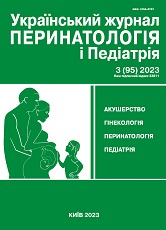Anxiety level in overweight and obese children
DOI:
https://doi.org/10.15574/PP.2023.95.61Keywords:
personal anxiety, situational anxiety, children, obesityAbstract
Purpose - to evaluate personal and situational anxiety levels in overweight and obese children.
Materials and methods. 153 children (72 girls and 81 boys) aged 12-17 were involved in the study at the Odesa Regional Children’s Clinical Hospital. Anthropometric indicators (weight, height, body mass index (BMI)) were assessed taking into account the sex and age of children. Based on BMI values, 3 groups were selected: 1 - children with a body weight corresponding to age and gender - 47 persons (Control); 2 - children with excessive body weight - 50 persons (Overweight); 3 - children with obesity - 56 persons (Obesity).
The state of personal and situational anxiety was determined using the Spielberger-Khanin questionnaire. Statistical data analysis was carried out using packages STATISTICA 12.0, MedCalc 20.0, Microsoft EXCEL 2003.
Results. In children with obesity, the most common comorbidities were biliary dyskinesia (14.28%), arterial hypertension (10.52%), skin infections 4% and obstructive sleep apnea syndrome 2%. In the studied groups of children, the level of anxiety increased in proportion to the degree of increase in body weight. Personal anxiety in children with obesity compared to control was noted at a higher level - 50.1±1.04 and 30.27±0.98, respectively (χ2=49.9, p=0.0001). Situational anxiety also increased in children with obesity, but the differences were expressed to a lesser extent - 38.94±0.74 and 33.91±0.93 (χ2=5.49, p=0.019).
Conclusions. The obtained results indicate the feasibility of further study and monitoring of the psycho-emotional state and quality of life of overweight and obese children and adolescents for individual psychological support and correction of psycho-emotional disorders.
The research was carried out in accordance with the principles of the Helsinki Declaration. The study protocol was approved by the Local Ethics Committee of participating institution. The informed consent of the patient was obtained for conducting the studies.
No conflict of interest was declared by the authors.
References
Apperley LJ, Blackburn J, Erlandson‐Parry K, Gait L. (2022). Childhood obesity: A review of current and future management options. Clinical Endocrinology. 96: 288-301. https://doi.org/10.1111/cen.14625; PMid:34750858
Aryayev M, Senkivska L, Lowe JB. (2021). Psycho-Emotional and Behavioral Problems in Children With Growth Hormone Deficiency. Frontiers in Pediatrics. 9: 1-6. https://doi.org/10.3389/fped.2021.707648; PMid:34631612 PMCid:PMC8495251
Baker C. (2019). Briefing paper: obesity statistics. House of Commons Library. 3336: 1‐20.
Centers for Disease Control and Prevention. (2021). Prevalence of childhood obesity in the United States. URL: https://www.cdc.gov/obesity/data/childhood.html.
Dovidnyk dytiachoho endokrynoloha. (2008). Tsentr medychnoi statystyky MOZ Ukrainy. Kyiv: 105.
Dyachuk DD, Zabolotnaya IE, Yaschenko YB. (2017). Obesity in children: risk factors and prevention tips. Sovremennaya pediatriya. 2 (82): 42-46. https://doi.org/10.15574/SP.2017.82.42
Hampl SE, Hassink SG, Skinner AC, Armstrong SC et al. (2023). Clinical Practice Guideline for the Evaluation and Treatment of Children and Adolescents With Obesity. Pediatrics. 151 (2): e2022060640. https://doi.org/10.1542/peds.2022-060640; PMid:36622115
Honcharenko T. (2004). Tryvozhna dytyna. Psykholoh. 5: 4-5.
Krushnapriya SS, Bishnupriya S, Choudhury AK, Bhadoria AS. (2015). Childhood obesity: causes and consequences. J Family Med Prim Care. 4 (2): 187-192. https://doi.org/10.4103/2249-4863.154628; PMid:25949965 PMCid:PMC4408699
Lemak MV, Petryshche VIu. (2012). Psykholohu dlia roboty. Diahnostychni metodyky: zbirnyk. Uzhhorod: Vydavnytstvo Oleksandry Harkushi: 616.
Livingstone B. (2000). Epidemiology of childhood obesity in Europe. Eur. J Pediatr. 159 (1): 14-34. https://doi.org/10.1007/PL00014363; PMid:11011953
Mouratidi P-S, Bonoti F, Leondari A. (2015). Children's perceptions of illness and health: An analysis of drawings. Health Education Journal. 75 (4): 1-14. https://doi.org/10.1177/0017896915599416
MOZ Ukrainy. (2022). Pro zatverdzhennia Standartiv medychnoi dopomohy «Ozhyrinnia u ditei». Nakaz MOZ Ukrainy vid 24.09.2022 No. 1732. URL: https://www.dec.gov.ua/wp-content/uploads/2022/09/2022_08_29_kn_ozhyrinnya-u-ditej.pdf.
Mykhailova EA, Kukuruza HV, Shestopalova LF, Pidkorytov VS. (2021). Kliniko-psykholohichni osoblyvosti ditei z riznymy formamy ozhyrinnia. Problemy endokrynnoi patolohii. 2: 56-63.
Skirda IYu, Petishko OP, Gladun VN, Zavgorodnyaya NYu. (2016). Ozhirenie v detskom vozraste. Statisticheskaya otsenka rasprostranennosti v Ukraine: regionalnyiy aspect. Gastroenterologiya. 1 (59): 8-14.
Tsyunchyk YuG. (2016). The clinical significance of psycho-emotional factors during the children's obesity. Sovremennaia pedyatryia. 5 (77): 98-101. https://doi.org/10.15574/SP.2016.77.98
WHO. (2021, Aug). Obesity and overweight: WHO; 2021. URL: https://www.who.int/news-room/fact-sheets/detail/obesity-and-overweight.
Zabolotna IE, Yashchenko LV. (2019). Ozhyrinnia ta nadmirna masa tila v ditei, kryterii diahnostyky ta statystyka poshyrenosti. Klinichna ta profilaktychna medytsyna. 2 (8): 36-46.
Downloads
Published
Issue
Section
License
Copyright (c) 2023 Ukrainian Journal of Perinatology and Pediatrics

This work is licensed under a Creative Commons Attribution-NonCommercial 4.0 International License.
The policy of the Journal “Ukrainian Journal of Perinatology and Pediatrics” is compatible with the vast majority of funders' of open access and self-archiving policies. The journal provides immediate open access route being convinced that everyone – not only scientists - can benefit from research results, and publishes articles exclusively under open access distribution, with a Creative Commons Attribution-Noncommercial 4.0 international license(СС BY-NC).
Authors transfer the copyright to the Journal “MODERN PEDIATRICS. UKRAINE” when the manuscript is accepted for publication. Authors declare that this manuscript has not been published nor is under simultaneous consideration for publication elsewhere. After publication, the articles become freely available on-line to the public.
Readers have the right to use, distribute, and reproduce articles in any medium, provided the articles and the journal are properly cited.
The use of published materials for commercial purposes is strongly prohibited.

